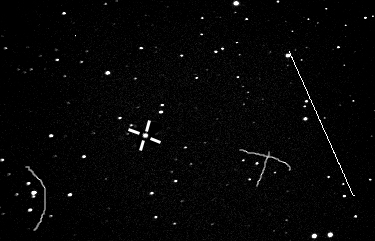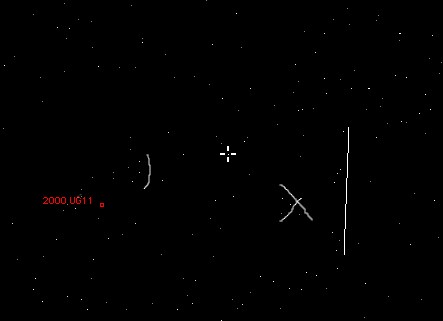
40 sec: Taken 3.11.2000 at Goodsell Observatory through an LX200 at f/6.3

Screen shot from Voyager of region of interest for 2000 UG11, with object marked in red
Well, here's the story of that night. Seeing as I was nowhere near the correct location on the
first, I decided to take a more systematic approach to positioning. The telescope drive mounts are
fairly accurate, but not necessarily good enough for how close I needed to get. The problem was,
on the days when the object would be brightest, it would be in a region of sky quite devoid of
bright stars or major non-stellar objects, so I would need to find another way of getting there,
since the inaccuracies in the drive mount mean that the farther you move it, the larger your
uncertainty in position. After playing around with Voyager (a star chart program that the college
has running on our Mac G4's... mmm... fast!), I decided that the way I could be most certain that I
was in the right area was by hopping between a series of dim galaxies. If I chose the spacing
between them to be small enough, the small drive errors would not be too bad and I could correct
once I had found the galaxy.
So, following this plan resulted in my arriving at where I thought I should be after about an
hour and a half of imaging, and the series of galactic images on the bottom of
that web page. At the end of that sequence, I was quite sure that I
had reached the right location, so I took many images, while moving the telescope around slight, in case I
wasn't completely accurate in my positioning. Eventually, I got tired enough that I had to go in (plus, it
was starting to get very cold, and I had class the next morning), so I decided to pack up the
equipment, go to bed and analyze the images in the morning.
The next morning, all I found were the two gamma ray hits in the images above. So, a few days
later, while helping Cindy with the Astronomy 113 lab, I noticed that it was possible to enter
orbital elements into Voyager! So I entered the data for 2000 UG11, moved the sky view to the
location it was supposed to be at the time I took the images and set the date and time for about the time
of the image below.. Here is a copy of the image I was comparing it to (same region as the above two,
just a different image). I've marked some bright star lines so that you can easily compare it with a
screen shot from Voyager.

40 sec: Taken 3.11.2000 at Goodsell Observatory through an LX200 at f/6.3

Screen shot from Voyager of region of interest for 2000 UG11, with object marked in red
You might just notice that the image ends slightly short of where voyager said the object should be.
If I would only have know about this feature in voyager, I might have been able to find it by comparing
the stars in my image with those on the screen. But I was really darn close. But not close enough.
Why the difference? Well, I found that if I moved the voyager time backwards an hour, the object
was almost exactly centered (well, it would have been just above the cross shaped set of stars). This
made me think. What would cause the hour difference? I double checked the positions I was using, as well
as the orbital data I had entered into Voyager. This is the position data I was looking at:
| Date | UT | R.A. | Dec | Delta | r | V | Constellation |
| Nov 04 | 0h | 3 18.2 | +28 08 | 0.036 | 1.026 | 14.4 | Ari |
| Nov 04 | 6h | 3 24.8 | +27 44 | 0.034 | 1.025 | 14.3 | Ari |
Both images are centered on the 06:00 Universial Time coordinates listed, since I knew we were 5
hours behind Universial Time here in Minnesota I took the images at about 1:00 am our time.
Well, not exactly....
You see, I had forgotten that daylight saving time had started, so we were actually 6 hours behind UT.
Thus the images that I took were an hour in the wrong direction, so 2000 UG11 had moved out of the field
of view of the camera! One more reason for me to dislike daylight saving time! The comparison image above
is the closest that I got to finding the object, all other images were farther away, either because I moved
the camera "right" or "up" or because when I went back there, it had moved farther "left." So next time,
I'll have to remember to do all of my calculations in UT (always check those units folks! avoid the
problems of the Mars Climate Orbiter!), and maybe I'll have better luck.
Here is some information from the data release that might be of interest. Seems like we'll
probably be seeing this object again in the near future, so maybe I'll get another chance at it!
"These elements show that 2000 UG11 completes a revolution around the Sun every 2.7 years, ranging
from as far out as 3.0 astronomical units (beyond the orbit of Mars) to as close as 0.8 a.u.
(well inside Earth's orbit). Spahr has assigned it a PHA (Potentially Hazardous Object) rating
of 0.005, meaning that it bears watching as a possible threat to Earth at some point in the future."